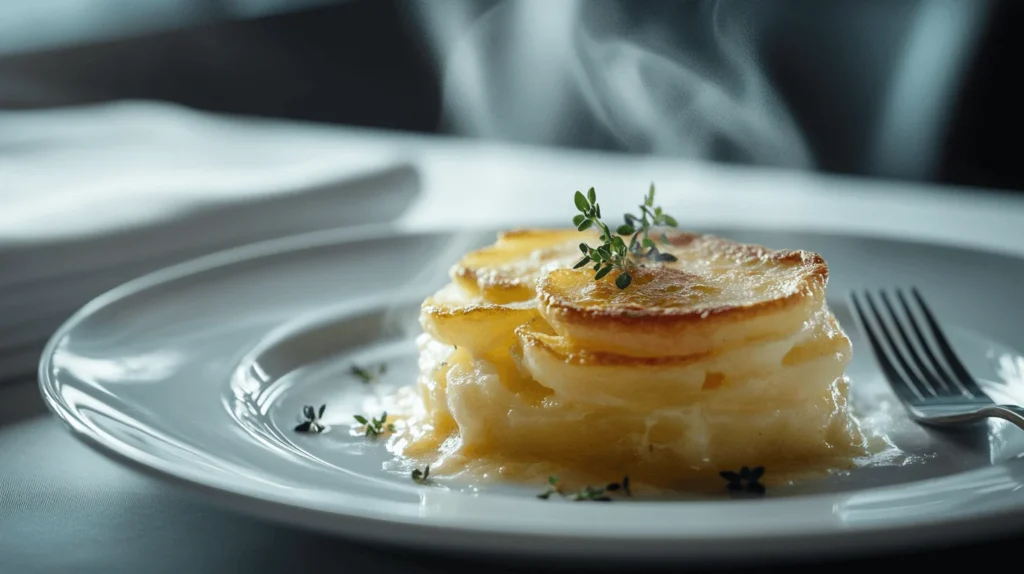Scalloped potatoes are a classic comfort food that brings warmth to any meal. However, when you ask, “How to Add More Flavor to Scalloped Potatoes?”, there are many simple yet impactful techniques to explore. Whether you’re preparing this dish for a holiday feast or a casual family dinner, enhancing its flavor profile can make all the difference. By selecting the right ingredients, perfecting the cooking process, and adding a few creative twists, you can elevate this dish from basic to extraordinary.
In this article, we will break down the essential steps and strategies to boost the flavor of your scalloped potatoes. From the type of potatoes you use to the addition of cheeses, seasonings, and garnishes, we’ll guide you on how to take your scalloped potatoes to the next level.
What Are Scalloped Potatoes and How to Boost Their Flavor?
Scalloped potatoes are a baked dish made primarily with thinly sliced potatoes, heavy cream, and seasonings, all cooked together until tender and golden. Unlike gratin, which typically includes cheese, scalloped potatoes focus on the richness of the cream and the flavor depth from the ingredients. The result is a creamy, flavorful side dish with a slightly crispy top.
To make the most of your scalloped potatoes, it’s important to understand the core elements of this dish. By carefully selecting the ingredients and techniques, you can ensure your potatoes come out with an irresistible flavor profile.
Pro Tip: For a step-by-step guide, explore The Ultimate Scalloped Potatoes Recipe with Cheese Powder to see how cheese powder can enhance your dish.
Traditional Preparation Methods and How to Improve Flavor in Scalloped Potatoes
In traditional scalloped potatoes, the potatoes are layered in a baking dish, and each layer is seasoned with salt, pepper, and sometimes garlic or onions. Heavy cream is poured over the potatoes to create a rich, creamy texture during baking. The flavors meld together as the potatoes absorb the cream and seasonings. This method allows the natural sweetness of the potatoes to shine while also enhancing the dish with savory undertones from the cream and seasoning.
However, the question remains: How Do You Make Paula Deen’s Scalloped Potatoes? Simple additions like different herbs, spices, or broths can help elevate the flavor and provide additional depth without changing the essence of the dish.
Understanding the Basic Ingredients: How to Enhance Flavor in Scalloped Potatoes
To make truly flavorful scalloped potatoes, understanding the key ingredients is crucial. The combination of potatoes, cream, and seasonings lays the foundation for the flavor, but how you handle each component can make all the difference in the final result.
For example, Michael Symon’s Trick for Perfect Scalloped Potatoes involves using unique techniques to layer and season the potatoes for maximum flavor impact.
Essential Ingredients to Add More Flavor to Scalloped Potatoes
The essential ingredients for a traditional scalloped potato recipe include potatoes, heavy cream, butter, and seasonings such as salt and pepper. However, to make the dish stand out, adding flavorful extras like cheese, garlic, or fresh herbs can make the flavor richer and more complex.
Here are some must-have ingredients:
- Potatoes: The base of the dish, contributing a mild, starchy flavor.
- Heavy cream: Adds richness and creaminess.
- Butter: For flavor and to promote browning during baking.
- Seasonings: Salt, pepper, garlic, and sometimes mustard, thyme, or rosemary.
Understanding how to balance these ingredients is crucial to getting the flavor profile right and knowing how to add more flavor to scalloped potatoes.

Why Potatoes, Cream, and Seasonings Are Key to Flavor in Scalloped Potatoes
The quality of the potatoes and cream used in scalloped potatoes significantly impacts the final dish. When choosing potatoes, it’s important to select a variety that holds up well to the baking process. The cream should be rich enough to create a luxurious sauce, while the seasonings should complement and not overpower the natural flavors of the dish.
For an optimal balance, it’s essential to:
- Select potatoes with a waxy texture for their ability to hold their shape.
- Use heavy cream for a velvety texture, though you can substitute half-and-half for a lighter version.
- Use seasonings sparingly and add them gradually to achieve the perfect flavor balance.
The Role of Potatoes in Flavor Enhancement: Selecting the Best Potatoes
Potatoes are the heart of scalloped potatoes, and their flavor plays a pivotal role in the overall taste of the dish. To make your potatoes stand out, it’s essential to choose the right variety and prepare them correctly.
Choosing the Right Type of Potato for More Flavor in Scalloped Potatoes
The type of potato you choose directly influences the texture and flavor of your scalloped potatoes. Starchy potatoes like Russets are excellent for mashed potatoes, but for scalloped potatoes, you want a waxy potato that holds its shape during baking.
- Yukon Gold potatoes: These potatoes are a perfect choice for scalloped potatoes. Their natural buttery flavor and creamy texture make them ideal for this dish.
- Red potatoes: Another great option, red potatoes hold their shape well and add a subtle sweetness to the dish.
When selecting potatoes, consider their texture and flavor profile. For the best results, choose waxy varieties that maintain their shape and provide a smooth texture when baked.
How Potato Variety Affects Flavor and Texture in Scalloped Potatoes
The choice of potato variety impacts both the texture and the flavor. Waxy potatoes, such as Yukon Gold or red potatoes, have a smooth, creamy texture when baked. In contrast, starchy potatoes tend to become more fluffy and dry, which may not lend itself well to the creamy nature of scalloped potatoes.
By selecting the right potato, you can control the texture of your dish. For a creamy, melt-in-your-mouth experience, opt for waxy potatoes that maintain their shape while absorbing the rich flavors of the cream and seasonings.
Flavor Boosting Ingredients
While potatoes are the main component of scalloped potatoes, additional ingredients can significantly boost the overall flavor. These ingredients can help you achieve a more complex and satisfying flavor profile, taking your dish beyond the basics.
Choosing the Right Cheese
Cheese is one of the best ways to add flavor to scalloped potatoes. The right cheese can elevate the dish, providing both richness and sharpness. Consider these options for the perfect cheese addition:
- Gruyère: Known for its nutty flavor, Gruyère cheese melts beautifully and adds depth to the dish.
- Cheddar: Sharp cheddar offers a bold flavor and a nice contrast to the creamy texture of the potatoes.
- Parmesan: For a salty, umami kick, grated Parmesan cheese can be sprinkled on top before baking.
A combination of different cheeses can create a richer flavor profile, and using a high-quality cheese can make a noticeable difference in the final dish.
Other Flavor-Enhancing Ingredients
Beyond cheese, there are many other ingredients that can enhance the flavor of your scalloped potatoes:
- Garlic: Fresh garlic or garlic powder can add a savory depth.
- Onions: Sautéed onions provide sweetness and complexity.
- Mustard: A small amount of Dijon mustard adds a tangy kick that pairs beautifully with the cream.
The right combination of these flavor-enhancing ingredients can bring out the best in your scalloped potatoes.
Cream and Broth for Richness
The richness of scalloped potatoes often comes from the cream or broth used in the recipe. These ingredients contribute to the dish’s smooth texture and full flavor, but there are several ways to customize them for maximum flavor.
Using Heavy Cream vs. Half-and-Half
Heavy cream is the traditional choice for scalloped potatoes because it provides a thick, luxurious texture. However, you can substitute half-and-half for a lighter option. While heavy cream will create a richer, more decadent dish, half-and-half will still give you a creamy texture with fewer calories.
If you prefer a lighter, less rich option, half-and-half is a great choice. However, if you’re seeking a more indulgent dish, heavy cream will make your scalloped potatoes extra creamy and flavorful.
Adding Broth for Flavor Complexity
Adding broth to your scalloped potatoes can increase the complexity of the flavor. Chicken or vegetable broth adds a savory element without overwhelming the richness of the cream. Broth can also help prevent the dish from becoming too heavy, allowing for a more balanced overall flavor profile.
Consider substituting part of the cream with broth to lighten the dish while adding more savory depth. The broth’s subtle flavors can enhance the cream and seasonings, making your scalloped potatoes more satisfying.
Layering Techniques for More Flavor
Layering is key in making scalloped potatoes flavorful. Each layer of potatoes and seasonings contributes to the overall taste and texture of the dish.
Creating Flavorful Layers with Ingredients
Layering the potatoes properly ensures that each slice is evenly coated with cream and seasonings. Start by arranging the sliced potatoes in overlapping layers. Between the layers, add seasonings like salt, pepper, and herbs to infuse flavor into every bite. You can also sprinkle cheese between layers for added richness.
The key to flavor in scalloped potatoes is even distribution. By layering the ingredients properly, each bite will have a balanced amount of flavor.

Adding Texture with Layers
Layers of potatoes also add texture to the dish. As the potatoes bake, the edges of the layers become slightly crispy while the interior stays creamy. This contrast in textures is one of the defining characteristics of scalloped potatoes and adds to the overall appeal of the dish.
For even more texture, you can top the dish with breadcrumbs or cheese before baking. The crispy topping will provide a satisfying crunch that contrasts with the smooth, creamy layers beneath.
Seasoning Scalloped Potatoes Perfectly
Seasoning is one of the most important aspects of creating flavorful scalloped potatoes. The right balance of seasonings can bring out the natural flavors of the potatoes and complement the creaminess of the dish.
Fresh Herbs and Spices
Fresh herbs like thyme, rosemary, and parsley can add a fragrant touch to your scalloped potatoes. Dried herbs work well too, but fresh herbs impart a brighter, more vibrant flavor.
Spices like nutmeg and paprika also work well in scalloped potatoes, adding depth and warmth. A pinch of nutmeg can bring out the sweetness of the potatoes, while paprika adds a subtle smokiness.
Using Aromatics for Extra Flavor
Aromatics like garlic and onions are often added to the cream or butter mixture, infusing the potatoes with a savory depth of flavor. You can sauté the garlic and onions before adding them to the dish to release their oils and maximize their flavor.
Aromatic herbs like bay leaves or sage can also be added to the cream mixture for added fragrance and richness. These subtle additions will deepen the overall flavor without overpowering the dish.
Cooking Methods for Intense Flavor
The method used to cook scalloped potatoes plays a significant role in the final flavor and texture. By carefully choosing your cooking technique, you can create a more flavorful and satisfying dish.
How Baking Affects the Flavor
Baking the scalloped potatoes allows the flavors to meld together. As the dish bakes, the potatoes absorb the cream and seasonings, creating a rich, cohesive flavor. The top layer also crisps up, adding a golden, slightly crunchy texture.
Baking is the most common method for cooking scalloped potatoes because it allows for even cooking and the development of deep, complex flavors.
Slow-Cooking for Rich, Tender Flavors
Slow-cooking is another method that can help develop rich, tender flavors in your scalloped potatoes. Cooking them slowly allows the cream and potatoes to meld together, resulting in a more tender texture and a stronger flavor profile.
If you choose to slow-cook your scalloped potatoes, you can prepare them earlier in the day and let them cook on low for several hours. This method can produce an even creamier and more flavorful dish.
Garnishing Scalloped Potatoes for More Flavor
While the main flavor of your scalloped potatoes comes from the ingredients themselves, garnishing the dish can add a fresh touch and enhance the overall presentation and flavor.
Creative Garnishing Ideas
For a creative garnish, consider adding fresh herbs like parsley or thyme to the top of the dish before serving. The freshness of the herbs contrasts beautifully with the rich, creamy potatoes.
You can also add a sprinkle of freshly grated Parmesan cheese on top for an added salty kick or a handful of crispy fried onions for a crunchy contrast.
Cheese Garnishes and Texture Variations
Another great garnish idea is to sprinkle extra cheese on top of your scalloped potatoes just before baking. As the cheese melts, it will form a golden, crispy crust that adds both flavor and texture.
Additionally, you can experiment with different types of cheese for the garnish. Gruyère or a sharp cheddar will provide different flavor profiles, giving your dish a unique twist.
Common Mistakes to Avoid in Flavoring
When preparing scalloped potatoes, it’s important to avoid common mistakes that can impact the flavor of the dish. Knowing how to properly balance and season your ingredients can help you avoid these pitfalls.
Balancing Flavors
One common mistake is over-seasoning the dish with too many spices or herbs. While it’s tempting to add lots of flavors, the goal is to enhance the potatoes without overwhelming their natural taste. Stick to a few key seasonings and balance them well.
Avoiding Flavor Overpowering
It’s also essential to avoid overloading the dish with ingredients that overpower the potatoes. For instance, too much cheese or heavy cream can mask the subtle flavors of the potatoes themselves.
By carefully balancing your ingredients and seasoning, you can avoid flavor overload and create a dish that is flavorful without being overwhelming.
Enhancing Flavor with Add-Ins
Sometimes, adding a little extra something to your scalloped potatoes can provide an entirely new flavor experience.
Adding Protein and Vegetables for Extra Taste
You can also add protein, such as crispy bacon or sausage, to your scalloped potatoes for added flavor. Vegetables like spinach or leeks can bring freshness and a slight crunch, providing a nice contrast to the creamy texture of the potatoes.
Substituting Ingredients for More Flavor
If you’re looking to change up the flavor profile, try substituting different types of cheese, broths, or seasonings. A smoky chipotle pepper or a splash of white wine can give your scalloped potatoes a unique twist.
FAQs
How can I make scalloped potatoes more creamy?
To make scalloped potatoes extra creamy, use heavy cream instead of milk or half-and-half. Adding a little bit of butter or cream cheese can also help increase the creaminess.
What type of potatoes are best for scalloped potatoes?
Waxy potatoes, such as Yukon Gold or red potatoes, are the best choice for scalloped potatoes. They hold their shape well and create a creamy texture.
Can I add other vegetables to scalloped potatoes?
Yes, vegetables like leeks, spinach, or mushrooms can be added to scalloped potatoes to bring additional flavor and texture.
How can I make scalloped potatoes spicier?
To add spice to your scalloped potatoes, consider adding red pepper flakes, spicy cheese, or a pinch of cayenne pepper to the cream mixture.
How can I make the dish ahead of time?
Scalloped potatoes can be made ahead of time and stored in the refrigerator for up to 24 hours. Simply bake them before serving.
Can I use skim milk instead of cream?
While you can use skim milk instead of cream, it will result in a less creamy and rich texture. For a creamier dish, it’s better to stick with full-fat cream or half-and-half.
Conclusion

Scalloped potatoes are a versatile and beloved dish that can easily be transformed with the right ingredients and techniques. By focusing on quality potatoes, choosing flavorful cheeses, layering with care, and seasoning properly, you can easily answer the question, “How to Add More Flavor to Scalloped Potatoes?”. Experimenting with additional flavor-boosting ingredients, creative garnishes, and even different cooking methods will help you achieve the perfect balance of flavors in your dish.
Now that you know the secrets to creating more flavorful scalloped potatoes, it’s time to put these tips into action and impress your guests with this creamy, savory side dish.

